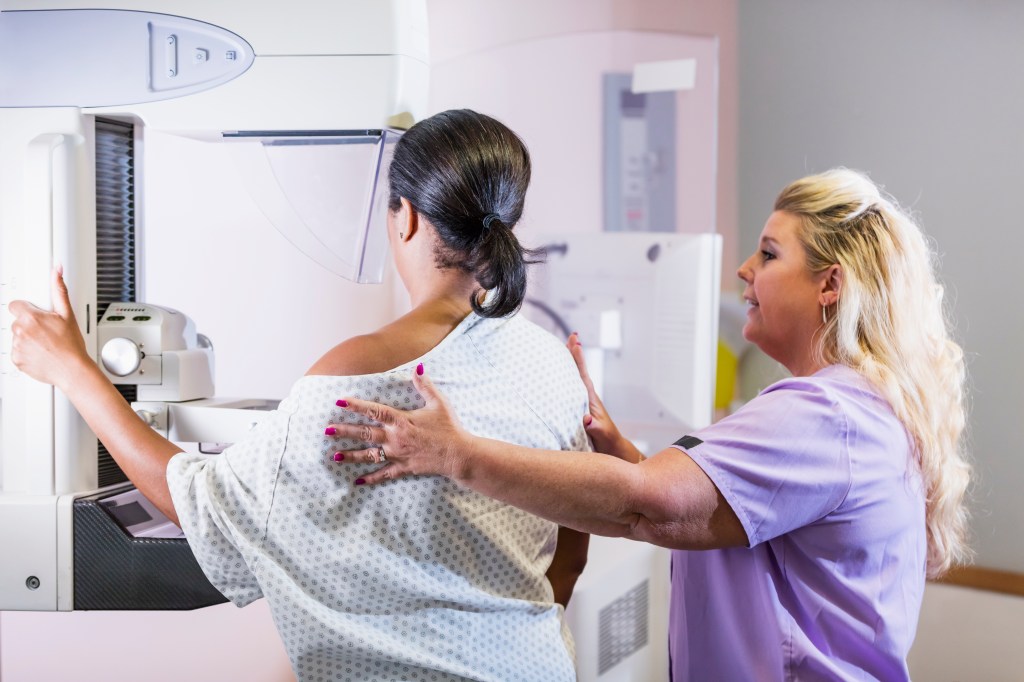Black Women and Breast Cancer Screenings: What to Know

[ad_1]
Breast cancer remains the second-most common cancer and the second-leading cause of cancer death among women in the United States. While overall breast cancer mortality has declined by 42 percent over the last three decades, according to the American Cancer Society (ACS), a persistent and alarming disparity exists: per the CDC, Black women are 40 percent more likely to die from breast cancer than white women, despite having a lower risk of being diagnosed with the disease.
This troubling statistic underscores the critical importance of early detection and appropriate screening for Black women. Here’s what you need to know about breast cancer screening guidelines and how to advocate for your health.
Understanding the Disparity
Several factors contribute to the higher breast cancer mortality rate among Black women. These include later-stage diagnosis, lower survival rates at every stage of diagnosis, and limited access to high-quality cancer treatment. These complex factors are fueled by systemic racism that limits access to high-quality cancer treatment, making it crucial for Black women to be proactive about their breast health.
Navigating Screening Guidelines
In the world of medicine, several leading independent organizations and panels make breast cancer screening recommendations and other cancer care guidelines. These reports can influence insurance coverage and help care providers decide on the best screening schedules for their patients. Two prominent organizations are the ACS and the United States Preventive Services Task Force (USPSTF).
The USPSTF recommends that women aged 40 to 74 get mammograms every two years. On the other hand, the ACS recommends annual mammograms for women ages 45 to 54, with the option to switch to every other year at 55 and older. They also suggest women should have the choice to start annual screening at age 40. To make screening guidelines even more confusing, The American College of Radiology recommends that all women, especially Black women, and women of Jewish descent, consult a doctor as early as age 25 to determine if they’re at a higher-than-average risk for breast cancer.
It’s crucial to understand that these are general guidelines, and your individual risk factors may warrant a different approach. Moreover, it’s important to know which guidelines your healthcare provider follows, as this can significantly impact your screening schedule and overall care.
Types of Screening Tests
The primary screening tool for breast cancer is the mammogram, often described as an X-ray of the breast, considered the best screening method for most women. For women who are at higher risk, breast MRI may be used in conjunction with mammograms. Clinical breast exams, performed by healthcare providers, and breast self-exams are also important components of breast health.
Because you’ve lived in your body your whole life, you are the first person to notice if something has changed, especially with your breasts. You can monitor changes in your breasts by doing a monthly self-exam after your period or on the same day each month if you’ve been through menopause. Each time you want to gently feel your breasts and look for any changes in appearance, such as dimpling, redness, or nipple inversion, and keep track of your findings to alert your healthcare clinician if you notice any changes. Remember, this self-exam complements but doesn’t replace regular mammograms and clinical exams. By knowing your body and increasing your breast self-awareness, you become your best health advocate.
The Reality of Healthcare Interactions
While guidelines often state that your healthcare provider will review the benefits and risks of screening with you to make an informed decision, the reality can be quite different. In an age of fifteen-minute appointments and clinician shortages, these in-depth discussions may not always happen. This makes it vital for you to be informed about screening guidelines and to advocate for the care you believe is best for you.
Furthermore, it’s important to be aware of potential clinician bias. Unconscious biases related to gender, socioeconomic status, race, or ethnicity can impact the quality of care you receive. By being informed and proactive, you can help ensure you receive appropriate and timely screening, regardless of these potential barriers.
Taking Control of Your Health
Given the disparities in breast cancer outcomes for Black women, it’s crucial to be proactive about your health. Start by knowing your risk: – discuss your personal and family history with your healthcare provider, including if genetic testing is recommended. However, it’s important to remember that over 85 percent of breast cancer cases occur in women with no family history of the disease, per research. This underscores the importance of regular screening for all women, regardless of family history.
Don’t hesitate to advocate for yourself. If you’re not satisfied with your current healthcare provider’s approach to breast cancer screening, seek out a provider who will listen to your concerns and tailor recommendations based on your risk of developing breast cancer. Remember, you have the right to request additional screening if you have concerns.
A Call to Action
As a Black woman, your health deserves priority. Don’t let systemic barriers prevent you from receiving the care you need. Stay informed about the latest guidelines and research on breast cancer screening. Knowledge is power, especially when it comes to your health.
Take action today:
- Book your mammogram now if you’re due, or set a calendar reminder to schedule it when the time comes.
- Familiarize yourself with your breast anatomy and become more breast self-aware.
- Research your family history of breast cancer and share it with your doctor.
- If you’re not satisfied with your current healthcare provider’s approach to breast cancer screening, seek out a provider who will listen to your concerns and tailor recommendations to you and your health risk.
Before you go, shop these gifts and products for breast cancer patients and survivors:
[ad_2]






